How to Use the USPTO Trademark ID Manual
When you’re ready to protect your brand with a trademark, one of the most critical steps is accurately describing what you’re selling. Too vague, and the USPTO might reject your application. Too narrow, and you might not get the protection you need. That’s where the USPTO’s Trademark ID Manual comes in—a free online tool that helps you identify the right language to describe your goods and services. In this guide, we’ll walk you through how to use it effectively, even if you’ve never filed a trademark application before.
What Is the Trademark ID Manual?
The Trademark ID Manual is the USPTO’s official database of pre-approved descriptions for goods and services.

Think of it as a dictionary that speaks the USPTO’s language. When you use descriptions from this manual, you’re choosing wording that trademark examiners already recognize and accept, which can help your application move more smoothly through the application examination process.
You can access the manual anytime at https://idm-tmng.uspto.gov/.
What the Manual Does (and Doesn't) Cover
The ID Manual provides thousands of accepted descriptions and shows you which classification category your products or services fall under—an important detail since trademark applications are organized by these international classifications. However, it’s not an exhaustive list. New products and innovative services emerge constantly, so you won’t find every possible description listed.
How to Search the ID Manual
Running a Simple Search
The easiest way to start is with a simple search on the main page. Just type your product or service into the search box and click the magnifying glass icon.
Example: If you type cook into the search box, the system will return all entries containing cook as well as related variations like cooked, cooking, and cooker. This is called “stemming”—where the system matches variations based on your search term’s root word.
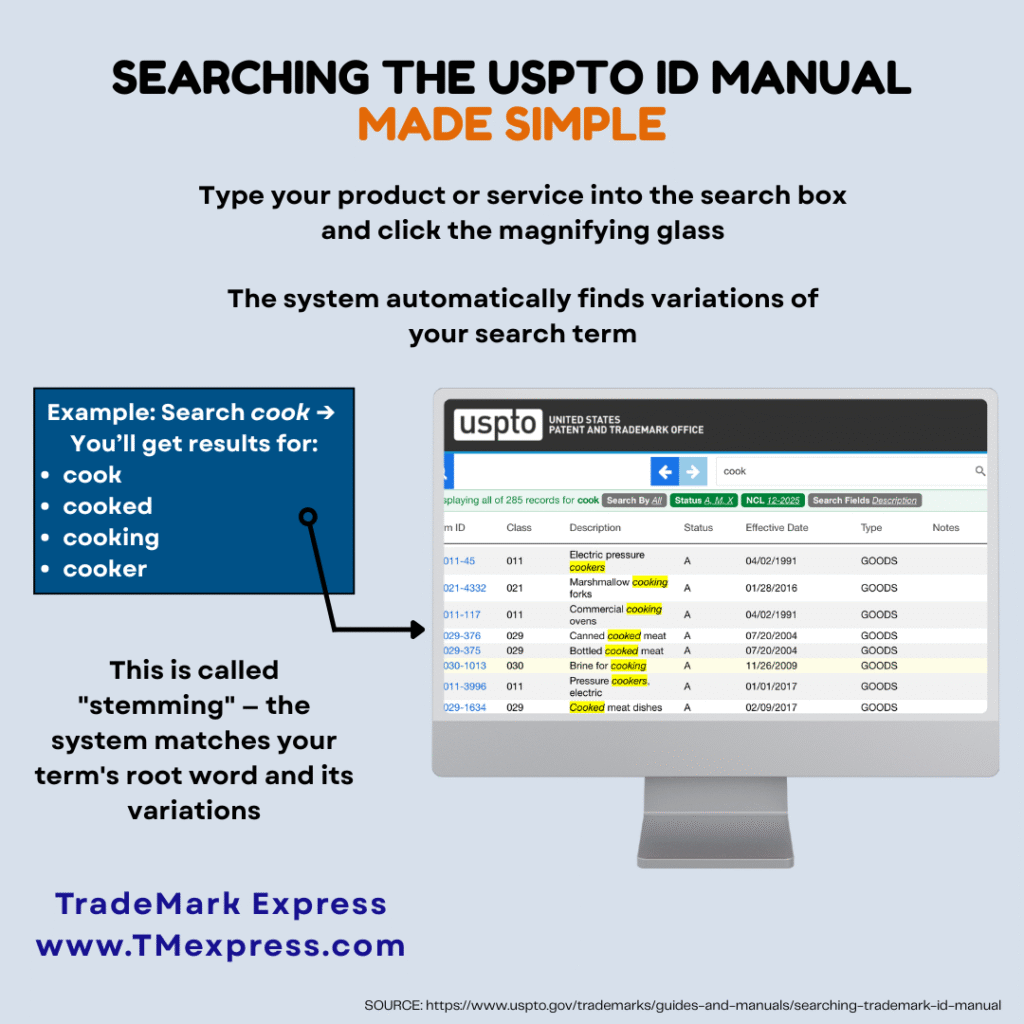
Getting More Specific Results
Sometimes you need more control over your search results. Here are a few techniques:
Exact Phrase Searches: Put your search terms in quotation marks to find that exact phrase in order. Searching for “medical apparatus” will only return entries with those two words together in that sequence.
Wildcard Searches: Use an asterisk (*) to replace characters. For example, cook* will find cooking, cookers, as well as cookie, cookbooks and cookware. This is particularly useful when you’re unsure of exact phrasing.
Multiple Word Searches: When you enter multiple words without quotation marks, the system automatically finds entries containing all those words. Searching copy paper returns results that include both terms.
Boolean Operators: You can use AND, OR, and NOT to refine searches. For instance, clothing NOT children will show clothing entries while excluding children’s apparel.
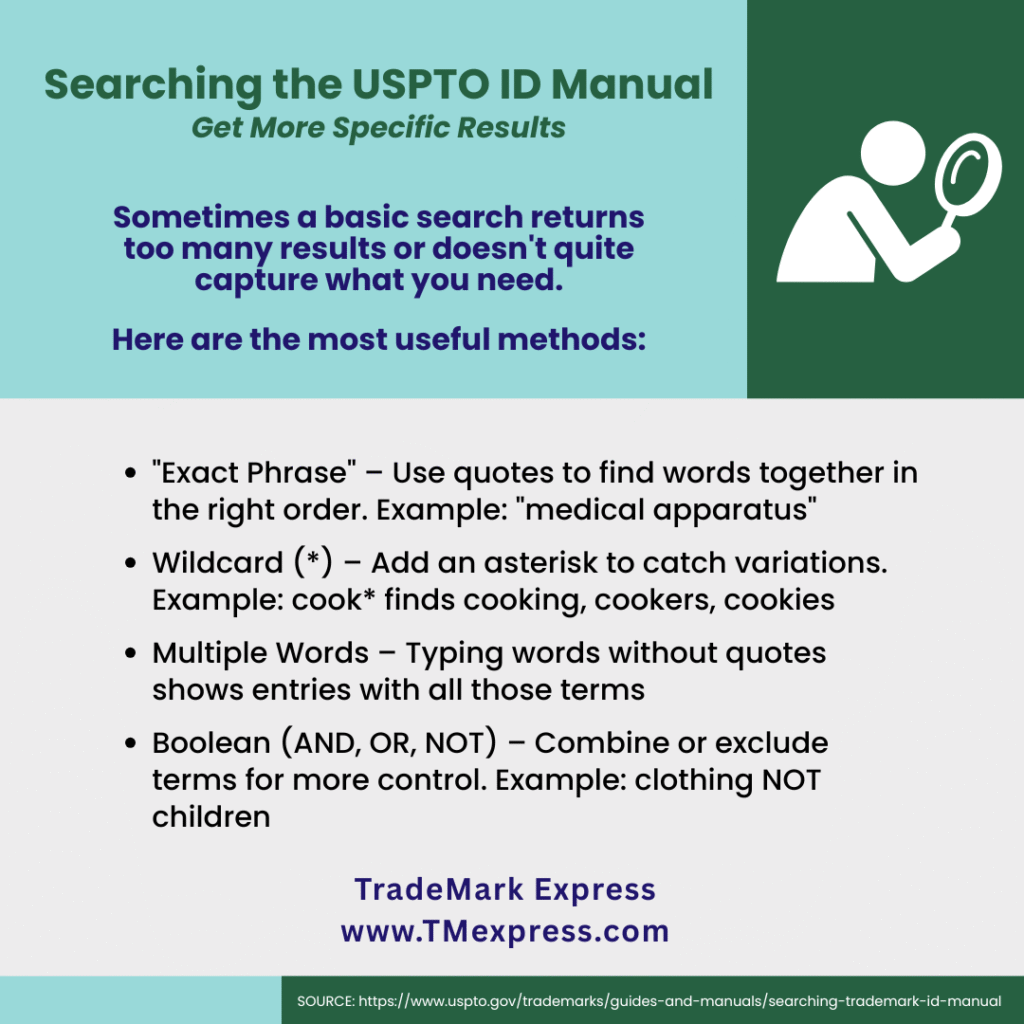
Advanced Search Options
The manual offers advanced search modes for more sophisticated queries:
- “All of the Words” mode: Finds entries containing every word you enter, in any order
- “Any of the Words” mode: Returns results with at least one of your search terms
- “Exact” mode: Returns only entries matching your search exactly, without stemming or variations
Tip: If you hit “Search” without entering anything in the box, the system will display every record in the database—helpful if you want to browse categories.
The Foundation: Comprehensive Trademark Research
Before you describe your goods and services, you need to know whether your trademark is actually available to use. This is where many entrepreneurs make a critical mistake: they assume a quick Google search or a simple USPTO database check is enough. In reality, thorough trademark research goes much deeper.
What Comprehensive Trademark Research Should Include
When evaluating whether your trademark is available, a proper search must examine multiple databases and look beyond exact matches. Here’s what should be included:
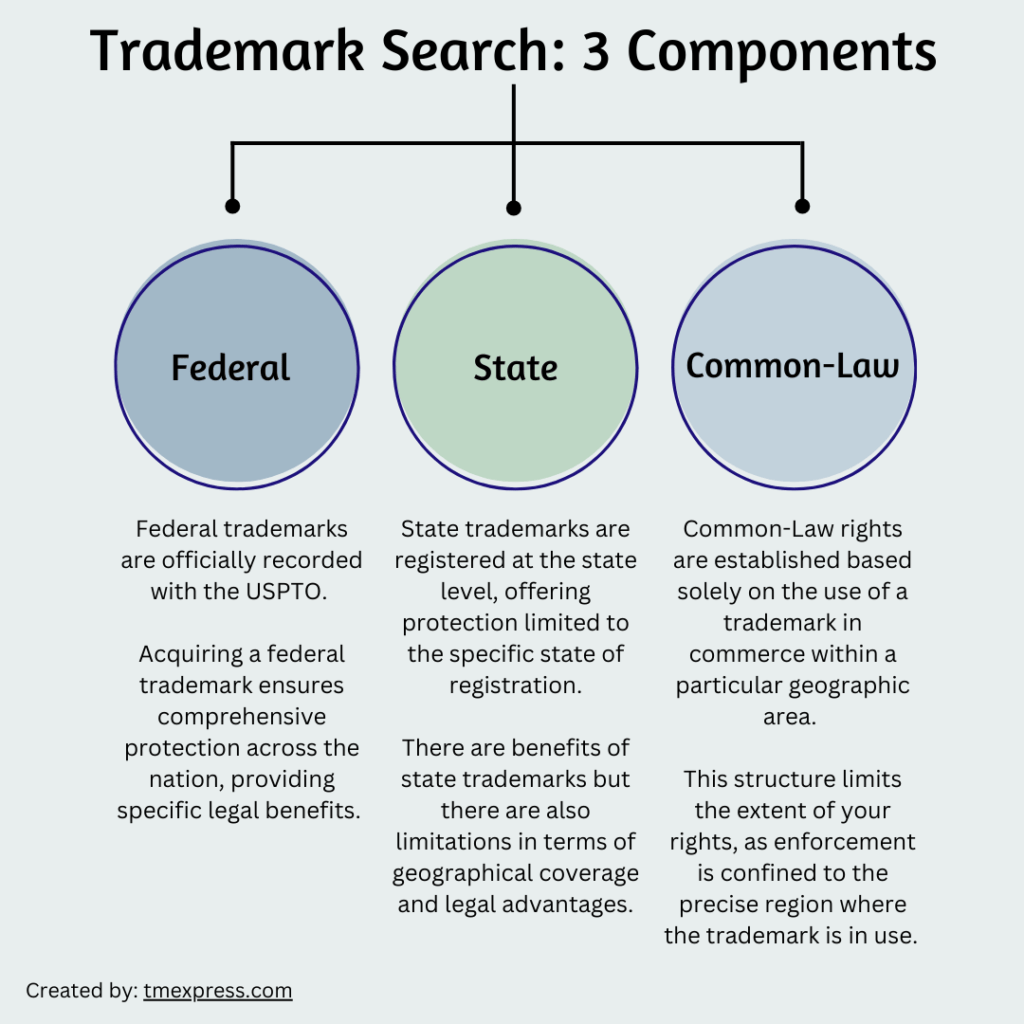
Federal Trademark Database Search: The USPTO database contains millions of registered and pending trademarks. But it’s not just about finding your exact name—you need to search for marks that are similar in the same or related goods and services categories. A mark doesn’t have to be identical to create a conflict; it just needs to be confusingly similar.
State Trademark Database Search: Not every business registers their trademark federally. Many companies file state-level registrations, which still give them legal rights in their state. A comprehensive search includes checking state databases to identify potential conflicts that wouldn’t appear in federal records.
Common Law Trademark Search: Here’s what surprises many business owners—you don’t need a registration to have trademark rights. Simply using a mark in commerce can establish “common law” rights. This means someone could have legal grounds to challenge your trademark even if they never filed any paperwork. Comprehensive research includes searching business directories, domain registrations, social media, and other sources to uncover these unregistered uses.
Looking Beyond Exact Matches: Sound, Appearance, and Meaning
One of the most important aspects of trademark research is examining similarities in three key areas:

Sound: Trademarks that sound alike can be considered confusingly similar, even if they’re spelled differently. For example, “Lyft” and “Lift” sound identical when spoken.
Appearance: Visual similarity matters, especially for logos and stylized text. Similar fonts, designs, or letter patterns can create confusion.
Meaning: Marks with similar meanings can conflict, even if the words are different. A trademark for “Ocean Breeze” cleaning products might conflict with “Sea Breeze” in the same category.
Why This Level of Research Matters
When you work with a trademark services provider or trademark attorney, make sure they’re conducting this comprehensive level of research. It’s not just about finding an available name—it’s about:
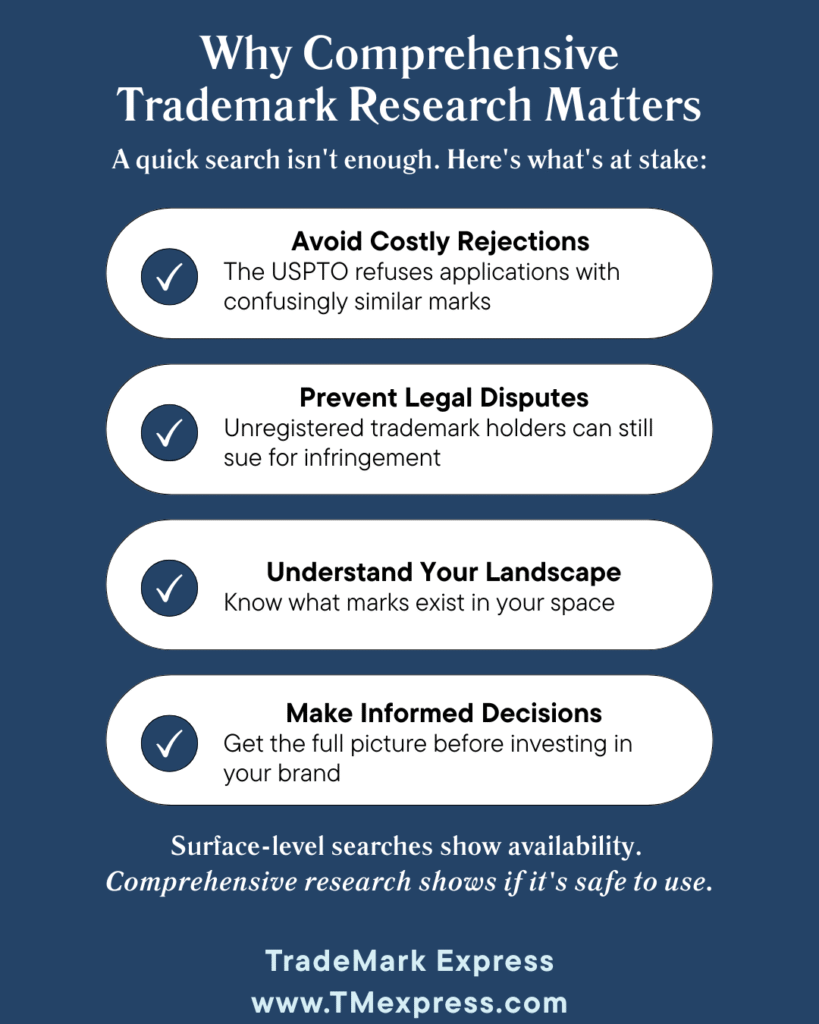
- Avoiding costly rejections: The USPTO will refuse your application if they find a confusingly similar registered mark
- Preventing legal disputes: Common law trademark holders can sue for infringement even without a registration
- Understanding the competitive landscape: Knowing what marks exist in your space helps you position your brand strategically
- Making informed decisions: Comprehensive research gives you the full picture before you invest in branding, packaging, and marketing
A surface-level search might tell you a name is “available,” but comprehensive trademark research tells you whether it’s actually safe to use.
Quick Tips for Using the Manual
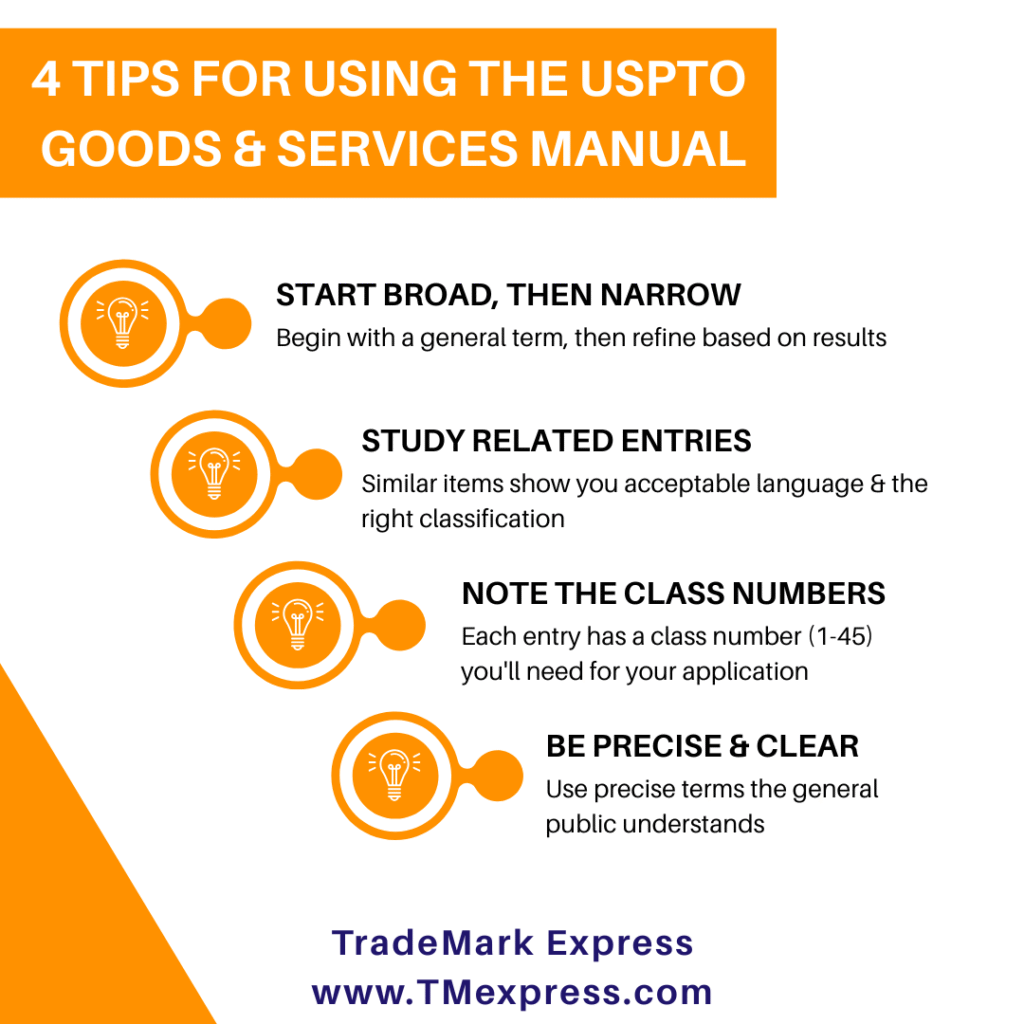
Start Broad, Then Narrow: Begin with a general term related to your product, review the results, and then refine your search based on what you find.
Look at Related Entries: Even if your exact product isn’t listed, similar items can guide you toward acceptable language and the right classification.
Note the Classification Numbers: Each entry includes a class number (Classes 1-45; A, B, 200). These classifications group similar goods and services together, and you’ll need to specify them in your application.
Be Clear and Specific: Use identifications that are clear and concise—terms that the general public would easily understand and that accurately describe your goods or services.
Conclusion
The USPTO Trademark ID Manual is an essential resource for preparing your trademark application. By learning to search it effectively, you’re taking an important step toward protecting your brand. Remember that accurate descriptions are just one part of a larger strategy—one that begins with a comprehensive trademark search to ensure your mark is available and positioned for approval.
The time you invest now can save you from rejections, delays, and potential conflicts down the road.
Ready to Start Your Trademark Journey?
Before you file your application, make sure your trademark has the best chance of approval. Order a comprehensive trademark search from TradeMark Express to uncover potential conflicts across federal, state, and common law databases. Our detailed research examines similarities in sound, appearance, and meaning—giving you the insights you need to make confident branding decisions. Get your trademark research started today and take the first step toward protecting your brand.
